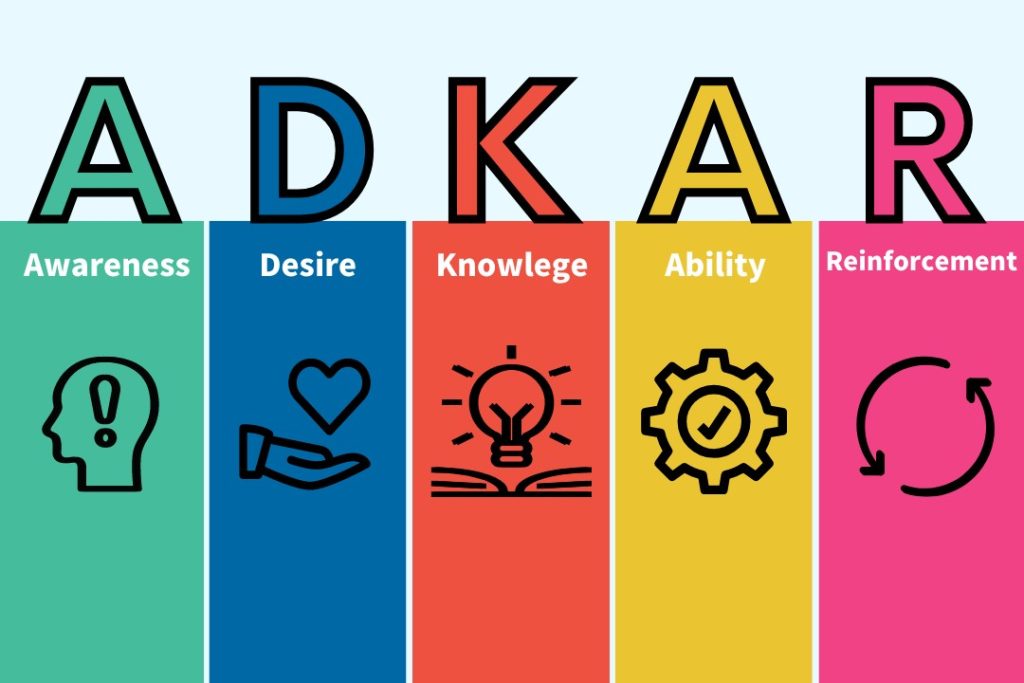
Introduction to the ADKAR Model
The ADKAR Model is a widely recognized framework used for managing both individual and organizational change. Developed by Prosci, its primary purpose is to guide employees and businesses through the change process by focusing on key human factors. Unlike some models that emphasize only organizational strategy, ADKAR centers on the people involved in the change, ensuring that each individual is prepared and able to adapt. This makes it a valuable tool for businesses seeking sustainable transformation, as successful change ultimately depends on individual adoption.
The ADKAR Model is structured around five essential components: Awareness, Desire, Knowledge, Ability, and Reinforcement. Awareness refers to the understanding of why the change is necessary, helping employees recognize the need to move away from the current state. Desire focuses on generating a personal motivation to support and engage with the change, which is crucial for overcoming resistance. Knowledge involves providing individuals with the information and training needed to carry out the change effectively. Ability goes a step further, ensuring that employees have the skills and tools to apply the change in their day-to-day activities. Finally, Reinforcement ensures that changes are maintained over time, preventing a return to old habits.
Learning how to apply the ADKAR Model equips organizations to manage change with a structured, people-centered approach. Each step ensures that employees are not only aware of the change but also equipped and motivated to embrace it. By addressing the human side of change, businesses can minimize resistance and increase the likelihood of long-term success. This model’s emphasis on both the individual and the organization makes it one of the most effective change management frameworks available.
Building Awareness of the Need for Change
Building awareness of the need for change is the first step in how to apply the ADKAR model effectively. In this phase, organizations must ensure that employees understand why the change is necessary. Communicating the reasons for change helps reduce uncertainty and provides a clear rationale for moving forward. Transparent communication is key to overcoming initial resistance, as employees are more likely to support changes if they understand the business drivers behind them, such as market competition, technology advancements, or internal inefficiencies. Leaders must deliver this message consistently across all levels of the organization, ensuring that every employee grasps the need for transformation.
To create awareness, it is important to use multiple communication channels, such as town hall meetings, internal newsletters, or one-on-one discussions, depending on the organizational structure. These channels help reach diverse audiences and ensure that everyone receives the same core message. Additionally, leaders should provide a platform for employees to ask questions and express concerns early in the process. By addressing fears and uncertainties upfront, organizations can build trust and foster an environment of openness. Early engagement also signals that leadership is committed to ensuring a smooth transition for everyone involved.
As businesses learn how to apply the ADKAR model, they must understand that building awareness is not a one-time event but an ongoing process. Regular updates about the progress of the change and reminders of the reasons behind it reinforce awareness. When employees feel well-informed and understand the stakes, they are more likely to align with the organization’s goals, paving the way for the next steps in the change process. This phase ensures that all employees are on the same page and ready to move forward with a clear understanding of the change’s importance.
Generating Desire to Support the Change
Generating desire to support change is a critical step in how to apply the ADKAR model. After building awareness, organizations must foster genuine employee willingness to embrace change. Leadership involvement is one of the most effective ways to build this desire. When leaders actively promote the change and demonstrate its importance, employees are more likely to follow. Leaders should not only communicate the benefits but also model the behaviors and attitudes aligned with the new direction. This visibility helps build trust and reinforces the importance of the change throughout the organization.
Incentives also play a major role in encouraging employees to support change. Recognition programs, performance bonuses, or career development opportunities reward early adopters and those who embrace the change. These rewards motivate others to engage fully. Tailoring incentives to what drives the team—whether monetary or non-monetary—ensures a more effective impact. When employees feel their efforts are valued, it creates a positive feedback loop that fosters further engagement.
Addressing resistance is another key strategy for building desire. Resistance often stems from fear of the unknown or discomfort with new processes. To manage this, leaders must listen to concerns, identify the root causes of resistance, and address them directly. Acknowledging concerns and offering support fosters a more open attitude toward the change. As businesses understand how to apply the ADKAR model, they see that creating a supportive, positive environment strengthens employee willingness, making the transition smoother and more successful.
Providing Knowledge and Skills for Successful Change
Providing employees with the necessary knowledge and skills is essential for successful implementation of organizational change. In the ADKAR model, the knowledge phase ensures that employees understand what is expected of them during the transition. Training programs are a crucial part of this phase. These programs can include workshops, online courses, or hands-on sessions that help employees learn new processes, technologies, or systems introduced by the change. Tailored training ensures that each employee has the specific knowledge they need to perform their roles effectively in the new environment.
Support mechanisms play an equally important role in equipping employees for successful change. Organizations should establish systems like mentorship programs, help desks, or peer support groups that provide ongoing assistance. These resources give employees the chance to ask questions, troubleshoot issues, and seek guidance as they adapt to the change. Continuous support reinforces learning beyond initial training and sustains it throughout the transition. Regular feedback helps organizations identify where employees need more knowledge or clarification.
Leadership involvement is critical in this phase, as well. Leaders should actively participate in training and support efforts to demonstrate their commitment to the change. When employees see leadership engaging with the same learning opportunities, it fosters a sense of unity and reinforces the importance of the change. Additionally, offering incentives for completing training programs can motivate employees to take learning seriously. As businesses continue to explore the ADKAR Model, they recognize that empowering employees with the right knowledge and resources ensures a smoother transition and better long-term outcomes.
Reinforcing Change to Sustain Long-Term Success
Reinforcing change is essential to ensure that new behaviors and processes are maintained for long-term success. In the ADKAR Model, reinforcement plays a critical role in solidifying changes and preventing a regression to old habits. Without ongoing reinforcement, the momentum gained during the early stages of change can fade, leading to a gradual return to previous practices. By actively reinforcing change, organizations create a culture of accountability and commitment, ensuring that the change remains effective over time.
One effective method of reinforcing change is through continuous feedback. Regular check-ins, performance reviews, and surveys help leaders understand how well employees are adapting to new processes. This feedback allows managers to identify areas where additional support or adjustments may be necessary. Furthermore, recognizing and rewarding individuals or teams who successfully embrace the change is another powerful way to reinforce desired behaviors. Incentives such as bonuses, promotions, or public acknowledgment serve as motivation for others to continue adopting the new practices.
Performance tracking plays a crucial role in sustaining long-term success by measuring the impact of changes on business performance. Monitoring key metrics allows organizations to evaluate efficiency, productivity, and customer satisfaction. Leaders can assess whether the change has achieved the desired effect by tracking this data. If performance declines or areas require improvement, organizations can intervene early to make necessary adjustments. Businesses that use feedback, rewards, and performance tracking as part of how to apply the ADKAR model create a strong framework for sustaining change. Reinforcement ensures employees stay committed, and the organization benefits from transformation over time.
Conclusion
In conclusion, the ADKAR Model is a structured, people-centered approach that ensures successful organizational change. By focusing on five components—Awareness, Desire, Knowledge, Ability, and Reinforcement—the ADKAR Model guides organizations through each transformation phase. Building awareness and generating desire establish a solid foundation for change. Providing employees with the necessary knowledge and skills ensures that the implementation process is effective and successful. Continuous feedback, rewards, and performance tracking reinforce the change and ensure employees sustain new behaviors over time. By applying the ADKAR Model, businesses can mitigate resistance, align their teams, and achieve lasting success in their change initiatives. Adopting this framework enables organizations to navigate the complexities of change while fostering a culture of adaptability and continuous improvement.


